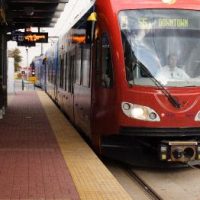TTT1136–Sept5-CentCorrHousing
Watch us from Studio 5! TruthToTell is now seen live on Livestream and later on Blip.tv or in iTunes
HELP US BRING YOU THESE IMPORTANT DISCUSSIONS OF COMMUNITY INTEREST – PLEASE DONATE HERE!
~~~~~~~~~~~~~~~~~~~~~~~~~~~~~~
The Central Corridor light rail system is taking shape – too slowly for many, fairly quickly for others. Rails have already been laid down close to the storage and maintenance facility that the old Gillette Building is becoming, but the infrastructure is taking shape along University Avenue as we watch the station stops rise from the rubble of sewer and electric re-installation and new road laid alongside the work now navigable. The cars will be running in 2014. There’s excitement in the air, along with consternation.
What remains less sure, especially as construction will start to enter the avenue segments much closer to businesses and residences in the eastern sector where small businesses and more modest homeowner fear a limited life in the midst of light rail disruption, is whether such small, often established Asian businesses and corridor residents of color can survive.
Housing is already in upheaval throughout that area, which includes the old Rondo neighborhood and Frogtown. Rondo – most of which remembers its destruction at the hands of highway engineers in the mid-1960s when I-94 was gouged out of the community – and sat there for months unfinished. Such events raise fears that the housing and commercial development craze that often accompanies rail transit projects will leave these same folks behind and behind the 8-Ball when it comes to home values, further foreclosures, and loss of business integrity.
When such development hits, land values shoot up because demand skyrockets around fixed rail. This puts present renters, homeowners and small businesses in a bind because they can see their property taxes and rents shoot up right along with those values, leaving current residents unable to pay the freight. It’s worse, of course, in this no growth, high unemployment economy when folks who live around there have lost their jobs in higher numbers than most. The unemployment rate in our core cities hovers around 20%-25% or more. Unforgivable that they should suffer any further. Housing affordability is paramount.
Most of the folks who live and work in these areas are getting their advocates out there and groups concerned with affordable housing issues are coalescing to plan and stave off the potential exploitation that often arrives with the rails. The Metropolitan Council will oversee affordable housing planning, but it should involve many organizations and communities.
TTT’s ANDY DRISCOLL and MICHELLE ALIMORADI query four of such activists – a small slice of the large community coming together – about the beginnings of plans to assure that housing that rises or survives in that area meets the needs of the community at least as much as those wishing to move into the new, transit-friendly structures that will dot the Central Corridor from downtown St. Paul to the Cedar-Riverside neighborhood in Minneapolis.
METRIC GILES – Organizing and Policy Specialist, Community Stabilization Project
EVE MARIE SWAN – Facilitator, Save Our Homes; Central Corridor Community Advocate
CAM GORDON – Councilmember, Ward 2, Minneapolis
CHIP HALBACH –Executive Director, Minnesota Housing Partnership
Additional resources:
CENTRAL CORRIDOR AFFORDABLE HOUSING PARTNERSHIP
Central Corridor & Affordable Housing Resource Library
“2 x 4″ Quarterly Housing Indicators
THE BIG PICTURE PROJECT Community Meeting Flyer
PROGRESS ON AFFORDABLE HOUSING DEPENDS ON BROAD COLLABORATION



